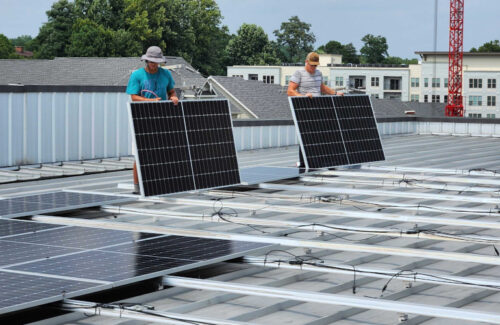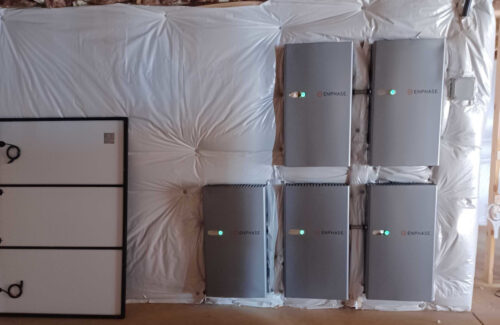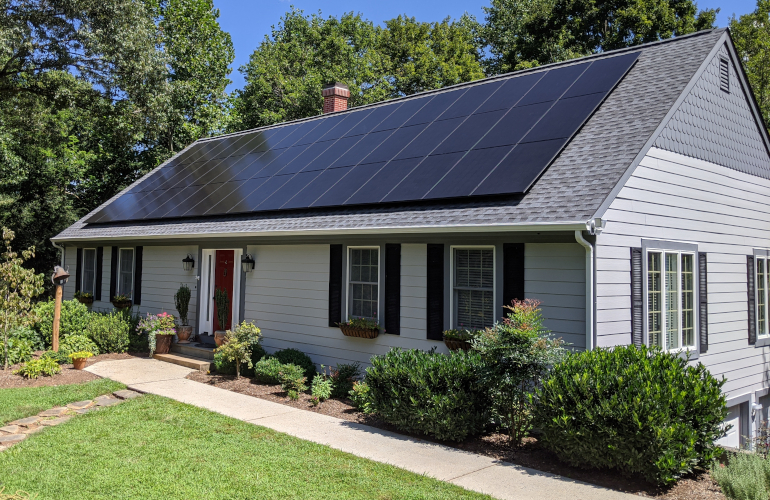Net measuring policy shifts throughout the country and solar installation companies have the right to worry. The NEM 3.0 of California has made the export compensation percentages, Hawaii transferred to a self-provision model and states such as Arizona and West Virginia have considerably reduced the net enlargement rates. Now Virginia is in sight, with Appalachian Power Company (APCO) to suggest To reduce the net reimbursement by more than 70%. When they are determined, these attacks on net measurement can have large effects on the solar industry.
For small solar installation companies this is a real threat – but there is hope. By looking at how markets such as California and Hawaii navigated similar shifts, we can take proactive steps to protect our companies and keep Solar viable.
Advocacy and coalition building: Fighting for honest policy

A residential solar storage project completed by Deugdzonne in Virginia.
If your state is confronted with a net meter overhaul, this is not over yet. Utility companies often try to push this policy quietly, but public pressure can shift the conversation. Here is how you can fight back:
- Work together with non -profit organizations and industrial groups – Organizations such as SEIA, Sierra Club, Solar United Neighbours and local environmental groups have experience in policy fighting and can help support support. Contact us and make or make coalitions so that you can make a coherent message that the myths perpetuate by tools.
- Training Ratepayers – Make sure that customers understand the full picture.
- Involved with legislators – Bring these issues to the attention of your state representatives. Many do not fully understand the benefits of distributed solar energy.
- Courageous public testimony – Nuts companies rely on a lack of public opposition. Mobilize customers to submit comments and attend hearings.
Policy can change if they are brought into the light. Public support has reversed or limited in various states, so do not assume that the fight has been lost.
Training customers and disprove the myth for cost shift

Credit: Virtue Zonne
An important part of advocacy is to ensure that customers understand why the arguments of utilities against net measurement are poor. Utilities claim that solar energy costs are shifting to non-Zonne customers, but study have repeatedly found little to no proof of this. In reality, distributed solar benefits are all Ratepayers by reducing the voltage on the grid, lowering the peak demand and reducing the need for expensive grid infrastructure upgrades.
If utilities are really worried about cost shifts, they would apply the principle evenly to their entire business model. Instead, they focus selectively on solar energy while ignoring the massive cost shifts that are inherent in their activities:
- Infrastructure costs for industrial customers – Residential Ratepayers usually subsidize the costs of grid extensions and power plants, even if the added demand comes from other sectors, such as industrial data centers – but utilities never call this as an unfair cost shift.
- National versus urban subsidies – Customers in the countryside require considerably more investment per head of the population to offer electrical service, but urban customers pay the same rates, so that the infrastructure costs in the countryside are effectively subsidized.
- Users with high energy versus low energy users – All living customers pay the same basic rate, but those who consume more electricity put a greater burden on the grid infrastructure. In many cases, households with lower energy consumption with lower energy consumption subsidize richer, higher households.
By resting customers with this knowledge, sun companies can reduce against the wrong information about usefulness and gathering stronger public support for honest energy policy.
Preparation for the worst: expand to storage

Enphase’s IQ Battery 5p. Credit: Virtue Zonne
The advantage of the poor network policy is that they make batteries a necessary investment. In California, the Battery mounting percentage rose up to 60% below NEM 3.0, an increase of only 10% below the old system. Hawaii, which left the net measurement years ago, now sees the battery of attachment rates of more than 90%.
Batteries enable homeowners to experience the energy they generate themselves, so that dependence on the net measurement is completely reduced. Instead of exporting excess solar energy to the grid at reduced speeds, homeowners can store who stores energy on the spot and draw on it when needed. Although it is true that fewer homeowners can choose to install solar energy without a strong network policy, those who can invest more in complete backup systems for solar energy + batteries. This increases the total value of each task, even if the total installation volume decreases.
What Zonne companies can do now:
- Place yourself as a battery expert – If you have not found a home battery package that you like, this is the time to learn one (or two) well and to be based with your representatives and suppliers.
- Learn homeowners on the tax credit – From now on, batteries are eligible for the federal tax credit of 30%, making them more affordable.
- Optimize for self -consumption – With lower export tariffs, customers will benefit most from the direct use of their solar energy. Helping customers in designing systems that give priority to energy consumption on site will ensure that they still see financial benefits despite network reductions.
Reflecting on a decade of sun growth
Despite challenges for the net policy policy, the solar industry has been seen a remarkable growth in recent decade, which offers a positive view of the future. The rapid progress in battery technology, reducing costs and growing environmental consciousness suggest a promising future for solar panels and storage. By staying aware of policy changes, innovations such as energy storage and arguing for supporting support policy, companies can continue to flourish and contribute to a landscape of sustainable energy enforcement.
Matt Powers is the founder of Solid sunAn installation company on solar energy in Charlottesville, Virginia. Matt is a master -electrician with more than 10 years of experience in installing and managing solar activities. Matt is passionate about sustainability, outdoor, rock climbing, local food and music, and wants you to have a great day.

